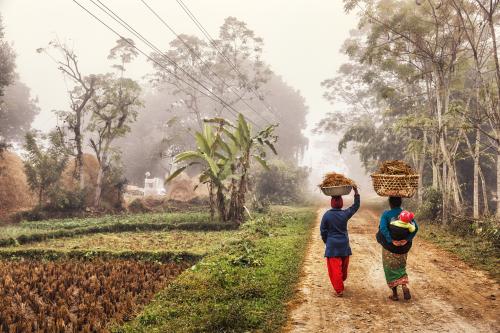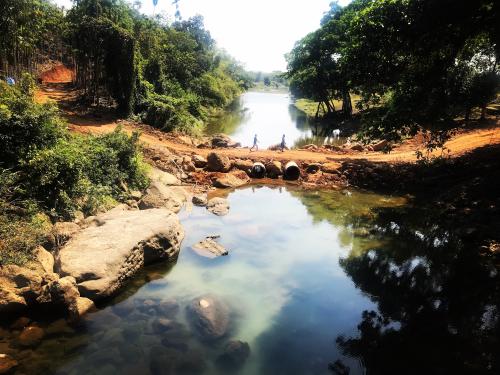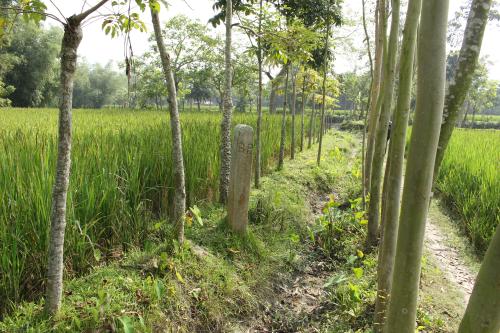Content from the Brookings Institution India Center is now archived. After seven years of an impactful partnership, as of September 11, 2020, Brookings India is now the Centre for Social and Economic Progress, an independent public policy institution based in India.
Sambandh Scholars Speak is a series of blog posts that feature evidence-based research on South Asia with a focus on regional studies and cross-border connectivity. The series engages with authors of recent books, articles and reports on India and its neighbouring countries.
In this edition of the Sambandh blog, Riya Sinha interviews Dr. Elisabeth Leake and Dr. Daniel Haines on their article, Lines of (In)Convenience: Sovereignty and Border-Making in Postcolonial South Asia, 1947-1965, published in the Journal of Asian Studies. The article combines archival history methodology with conceptual insights from political geography and critical international relations. Through two case studies – the Durand Line between Pakistan and Afghanistan and the India-Pakistan ceasefire line in Kashmir – the article demonstrates that during the 1950s and 1960s, the political elites in South Asia exercised sovereignty in border areas through centre-led border policies that rejected competing authorities and were often in conflict with local specificities of the inhabitants.
Q: In the article [1], you refer to border-making as a ‘top-down’ process wherein the state’s attempt to impose sovereignty over a territory contradicts with the lived realities of borderland inhabitants. What are the differences in the post-colonial state’s and the residents’ vision of a borderland and why did they emerge so?
A: For many states that gained independence from empires in the twentieth century, one of their first priorities was to establish political legitimacy – among their neighbours and the international community, as well as their citizens. Across the world, but especially in South Asia, securing borders was a key way of doing this. A clear border distinguished a state from their neighbours and created a geographical arena for nation-building. In contrast, many communities in borderlands had lives and livelihoods that historically sprawled across ambiguous imperial frontiers – before decolonisation, they had no need to see themselves as belonging either to one country or the other. Their social, political, and economic relationships were rooted in local and regional networks that did not necessarily correspond to the new borders. Their daily practices consequently came up against the state’s attempts to delineate its authority. Our article speaks to a key issue in the twentieth century: not all people assumed that ‘the nation-state’ would come to define national and international politics. This was something that developed over the mid-twentieth century, and borders were a key part of this.
 Q: The article compares the ‘inherited’ Durand boundary line between Afghanistan and Pakistan, and the ‘artificial’ ceasefire line that divides the erstwhile princely state of Jammu and Kashmir. Beyond militarisation, what attempts were made by Pakistan to establish sovereignty? How did Pakistan’s approach differ in both areas?
Q: The article compares the ‘inherited’ Durand boundary line between Afghanistan and Pakistan, and the ‘artificial’ ceasefire line that divides the erstwhile princely state of Jammu and Kashmir. Beyond militarisation, what attempts were made by Pakistan to establish sovereignty? How did Pakistan’s approach differ in both areas?
A: Pakistan used economic development and governing initiatives to establish state authority and develop relationships with local populations. In Pakistan-administered Kashmir,[2] Karachi/Islamabad influenced governance by ‘loaning’ civil servants to the local government. The Pakistan government also built the Mangla Dam near Mirpur, which strengthened infrastructural links between Kashmir and West Pakistan, and promoted small-scale development projects for agriculture and forestry. Development was also important along the Durand Line, where the government built local industries and infrastructure. They believed that ‘if the economic standard of the tribesmen is raised, they will be less susceptible to temptation’ from Afghanistan – and more loyal to Pakistan. Pakistan successfully outcompeted the Afghan government in development, which had fewer resources, yet took only limited steps to integrate the region politically. Instead, they left a system of ‘tribal’ government in place while continuing to rely on collective punishment, systems which have only begun changing recently. In both these regions, governance was, and has been, simultaneously weaker yet more authoritarian than elsewhere in Pakistan.
Q: Many states in the Indian subcontinent seek to undo colonial-era injustices in the creation of modern nation-states and this is a major cause of insecurity in the region. Do you think that the imaginations of borderlands have evolved over-time in the subcontinent with the operationalisation of the border-haats between India-Bangladesh or the cross-line of control trade and travel in Jammu and Kashmir by India and Pakistan?
A: The legal and moral justifications that state elites have applied to different borders in South Asia have changed over time. Similarly, certain borders have become more or less important depending on regional relations. None of South Asia’s national leaders have ever had a single, coherent ‘border logic’ – they have always acknowledged that different borders in the region have different functions, and in turn, deserve different policies. Perhaps what’s more significant is that while some border stretches remain contested, even more borders, both of the colonial era and post-1947, are largely acknowledged and respected for the majority of the time. Even if some of these borders remain legally disputed, in practice they continue to function as dividers between nation-states. But borders also serve as useful flashpoints in time of conflict. Closing a border provides a clear way for state elites to demonstrate that they take a conflict seriously. The operationalisation of borders – when people and goods can or cannot cross a border – has just helped to make regional tensions more visible.
Q: You delve extensively into archival research as a methodology. How did you overcome the biases in the political rhetoric of India, Pakistan and Afghanistan between 1947-65? What lessons would you like to share for budding scholars conducting archival research?
A: We were lucky enough to be able to work in government archives in India, Pakistan, the US and the UK for this article, helping us triangulate information despite the biases that officials in each government had. Because border issues are still sensitive for India and Pakistan and documents remain classified, the Western archives were essential for understanding the histories of those areas. The security situation in Afghanistan made research there impossible, and our sources for Afghan perspectives had to be teased out from materials gathered across all of the archives (the National Archives of India proved particularly useful).
If you want to conduct archival research, be prepared to spend time getting to know how information was recorded. A lot of diplomatic reporting in the 1950s-60s was quite formulaic, so with experience, you learn to quickly find the information you need. But remember that government reports and letters were written by individuals, who had their own points of view, and archives record arguments and contradictions as well as decisions. A lot of US and Indian documents have been made available online, which should help scholars pursue future research.
About the Experts:
 Elisabeth Leake is Associate Professor of International History at the University of Leeds, UK. Her first book, The Defiant Border: The Afghan-Pakistan Borderlands in the Era of Decolonization, 1936-65, explores the ongoing significance of the Durand Line in regional and international relations. She is currently writing a new international history of the Soviet invasion of Afghanistan.
Elisabeth Leake is Associate Professor of International History at the University of Leeds, UK. Her first book, The Defiant Border: The Afghan-Pakistan Borderlands in the Era of Decolonization, 1936-65, explores the ongoing significance of the Durand Line in regional and international relations. She is currently writing a new international history of the Soviet invasion of Afghanistan.
Contact: [email protected]
 Daniel Haines is Senior Lecturer in Environmental History at the University of Bristol, UK. He has published two books about dam-building and river-water disputes in India and Pakistan, including Indus Divided: India, Pakistan and the River Basin Dispute, and is currently writing a political history of earthquakes in colonial India.
Daniel Haines is Senior Lecturer in Environmental History at the University of Bristol, UK. He has published two books about dam-building and river-water disputes in India and Pakistan, including Indus Divided: India, Pakistan and the River Basin Dispute, and is currently writing a political history of earthquakes in colonial India.
Contact: [email protected]
[1] Elisabeth Leake and Daniel Haines, “Lines of (In)Convenience: Sovereignty and Border-Making in Postcolonial South Asia, 1947-1965,” Journal of Asian Studies, 76, no. 4, ISSN 0021-9118, (2017): 963-985, http://eprints.whiterose.ac.uk/112181/1/JAS-D-15-00222_R1.pdf
[2] Disclaimer: The authors of the article use the terminology Pakistan-administered Kashmir and India-administered Kashmir to refer to the territories across the Line of Control in Jammu and Kashmir. The use of these terms do not reflect the views of Brookings Institution India Center (BIIC).
The Brookings Institution is committed to quality, independence, and impact.
We are supported by a diverse array of funders. In line with our values and policies, each Brookings publication represents the sole views of its author(s).






Commentary
Linking border-making and sovereignty in postcolonial South Asia
May 28, 2020